Fishes
Media

Species Types
Scientific Name
Alosa chrysochloris
Description
The skipjack herring is an active fish, moving about continuously in large schools. It probably occurs at least occasionally in most of the large rivers of the state where its migrations are not blocked by dams.
Media
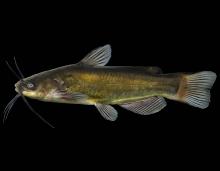
Species Types
Scientific Name
Ameiurus melas
Description
The black bullhead is widespread in Missouri. It is the most common bullhead catfish in north and west portions of the state. It has dusky or black chin barbels, and the edge of its tail fin is notched, not straight.
Media

Species Types
Scientific Name
Esox americanus vermiculatus
Description
The grass pickerel is the most common and widely distributed pike in Missouri. It is also the smallest, seldom exceeding 10 or 12 inches in length.
Media
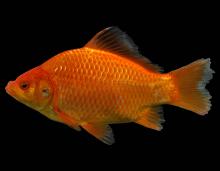
Species Types
Scientific Name
Carassius auratus
Description
Goldfish are not native to North America. They often escape into the wild from bait buckets and other causes, but there are few self-sustaining populations in Missouri.
Media

Species Types
Scientific Name
Cyprinus carpio
Description
The common carp is a "whopper" member of the minnow family. Originally from Asia, it was actively stocked in America in the 1800s and was firmly established in Missouri by 1895.
Media

Species Types
Scientific Name
Lepomis cyanellus
Description
The green sunfish is thick-bodied with a large mouth. The upper jaw extends to about the middle of the eye. It may occur in just about any pond, lake, or stream that is capable of supporting fish life.
Media
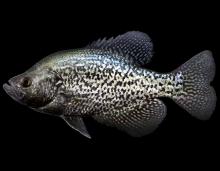
Species Types
Scientific Name
Pomoxis nigromaculatus
Description
The black crappie is a popular panfish. It is deep bodied and slab sided. The sides are silver with an irregular pattern of dark speckles. The upper jaw is long, reaching past the middle of the eye.
Media
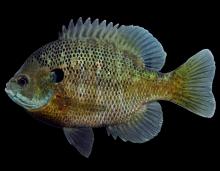
Species Types
Scientific Name
Lepomis macrochirus
Description
The bluegill is one of the most abundant and popular panfishes in North America. This deep-bodied, slab-sided sunfish sports a black “ear flap” extending from the edge of its gill cover.
Media
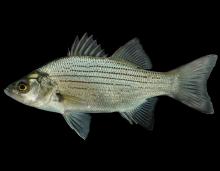
Species Types
Scientific Name
Morone chrysops
Description
The white bass is one of the most important game fish in Missouri’s large impoundments. It inhabits the deeper pools of streams and the open water of lakes and reservoirs.
Media

Species Types
Scientific Name
Lepisosteus osseus
Description
The longnose gar has a longer, narrower snout than our other three gars and is the most widely distributed gar in Missouri.
See Also


Media

Species Types
Scientific Name
Amphiuma tridactylum
Description
The three-toed amphiuma is an eel-like, completely aquatic salamander. It has very small forelimbs and hind limbs, each with three tiny toes. In Missouri it’s found only in the Bootheel region.
Media

Species Types
Scientific Name
Siren intermedia nettingi
Description
The western lesser siren is an eel-like, aquatic salamander with external gills, small eyes, small forelimbs with four toes, and no hind limbs. In Missouri, it’s found mostly in the Bootheel and northward in counties near the Mississippi River.
About Fishes in Missouri
Missouri has more than 200 kinds of fish, more than are found in most neighboring states. Fishes live in water, breathe with gills, and have fins instead of legs. Most are covered with scales. Most fish in Missouri “look” like fish and could never be confused with anything else. True, lampreys and eels have snakelike bodies — but they also have fins and smooth, slimy skin, which snakes do not.





















